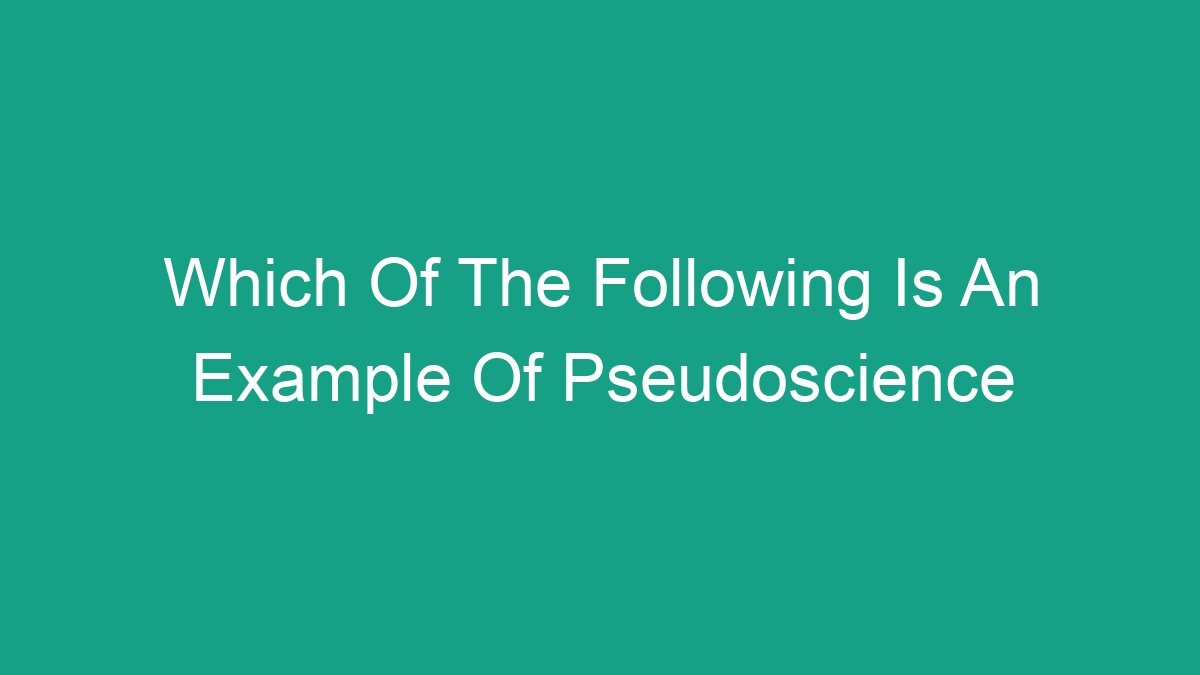
When it comes to separating fact from fiction in the world of science, it can be challenging to navigate the vast array of information available. Pseudoscience, in particular, is a term used to describe theories, beliefs, or practices that are portrayed as scientific but lack evidence, proper methodology, or scientific validity. It’s important to be able to recognize examples of pseudoscience in order to make informed decisions and avoid falling victim to false claims. In this article, we will explore some common examples of pseudoscience and how to identify them.
Examples of Pseudoscience
There are numerous examples of pseudoscience that can be found in various areas of society. From health and wellness to paranormal phenomena, pseudoscientific beliefs can present themselves in many different forms. Here are a few common examples:
- Astrology: Astrology is the belief that the positions and movements of celestial bodies can influence human affairs and natural events. Despite its widespread popularity, astrology lacks empirical evidence and scientific validity.
- Creationism: Creationism is the belief that the universe and living organisms originate from specific acts of divine creation, as opposed to the scientific theory of evolution. While creationism is based on religious beliefs, it has been presented as a scientific theory without the support of empirical evidence.
- Homeopathy: Homeopathy is a form of alternative medicine based on the concept of treating “like with like” and diluting substances to the point where they no longer contain any molecules of the original substance. Despite the lack of scientific evidence supporting its efficacy, homeopathy continues to be used and promoted as a legitimate medical practice.
- UFOlogy: UFOlogy is the study of unidentified flying objects (UFOs) and the belief that extraterrestrial beings have visited Earth. While there have been countless reports of UFO sightings, the scientific community maintains that there is no credible evidence to support the existence of extraterrestrial visitation.
- Crystal healing: Crystal healing is the belief that crystals and gemstones possess healing powers that can be used to balance energy and promote physical and emotional well-being. Despite the lack of scientific evidence to support these claims, crystal healing remains a popular practice in alternative medicine.
Identifying Pseudoscience
Recognizing pseudoscience can be challenging, especially when it is presented in a way that appears legitimate and scientific. However, there are several key indicators that can help you identify pseudoscientific beliefs and practices:
- Lack of empirical evidence: Pseudoscientific beliefs typically lack empirical evidence or rely on anecdotal accounts rather than rigorous scientific research.
- Unfalsifiability: Pseudoscientific claims often cannot be tested or disproven through experimentation, which is a fundamental principle of the scientific method.
- Extraordinary claims: Pseudoscience often involves making extraordinary claims that are not supported by scientific consensus or established scientific knowledge.
- Appeal to authority: Pseudoscientific beliefs may rely on the endorsement of individuals or organizations that lack scientific credibility.
- Use of jargon: Pseudoscientific claims may utilize scientific-sounding language and terminology to create an illusion of legitimacy.
Implications of Pseudoscience
The proliferation of pseudoscience can have significant implications for individuals and society as a whole. When pseudoscientific beliefs are perpetuated and accepted as valid, it can lead to various negative consequences:
- Health risks: Pseudoscientific health practices can pose significant risks to individuals who forego evidence-based treatments in favor of alternative therapies with no proven efficacy.
- Waste of resources: Governments, organizations, and individuals may invest time and resources into pseudoscientific endeavors that ultimately yield no tangible benefits.
- Undermining scientific literacy: Acceptance of pseudoscience can contribute to a lack of critical thinking and scientific literacy, leading to a society that is more susceptible to misinformation and false claims.
- Public policy decisions: Pseudoscientific beliefs can influence public policy decisions, leading to the implementation of ineffective or harmful policies based on unfounded claims.
Combatting Pseudoscience
Combatting pseudoscience requires a concerted effort to promote science literacy, critical thinking, and evidence-based reasoning. Here are some strategies for addressing pseudoscientific beliefs:
- Educational initiatives: Investing in science education and promoting critical thinking skills can help individuals recognize pseudoscience and make informed decisions.
- Public awareness campaigns: Raising awareness about the dangers of pseudoscience and providing accurate information can help combat the spread of false beliefs.
- Media literacy: Encouraging media literacy and skepticism of sensationalized claims can help individuals critically evaluate information they encounter.
- Supporting evidence-based practices: Encouraging the use of evidence-based practices in medicine, education, and public policy can help mitigate the influence of pseudoscience.
Conclusion
Pseudoscience presents a significant challenge in the realm of science and society, as it can lead to the spread of false beliefs, misinformation, and potential harm. By understanding examples of pseudoscience and learning to identify its key characteristics, individuals can play a role in combatting its influence. It’s crucial to promote science literacy, critical thinking, and evidence-based reasoning in order to address the implications of pseudoscientific beliefs and practices. Through education, public awareness, and support for evidence-based practices, we can work towards a society that values scientific integrity and embraces the pursuit of knowledge grounded in rigorous inquiry.


